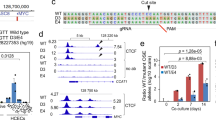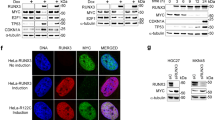Abstract
Transforming growth factor-β (TGFβ) is a cytokine that arrests epithelial cell division by switching off the proto-oncogene c-myc and rapidly switching on cyclin-dependent kinase (CDK) inhibitors such as p15INK4b. Gene responses to TGFβ involve Smad transcription factors that are directly activated by the TGFβ receptor. Why downregulation of c-myc expression by TGFβ is required for rapid activation of p15INK4b has remained unknown. Here we provide evidence that TGFβ signalling prevents recruitment of Myc to the p15INK4b transcriptional initiator by Myc-interacting zinc-finger protein 1 (Miz-1). This relieves repression and enables transcriptional activation by a TGFβ-induced Smad protein complex that recognizes an upstream p15INK4b promoter region and contacts Miz-1. Thus, two separate TGFβ-dependent inputs — Smad-mediated transactivation and relief of repression by Myc — keep tight control over p15INK4b activation.
This is a preview of subscription content, access via your institution
Access options
Subscribe to this journal
Receive 12 print issues and online access
$209.00 per year
only $17.42 per issue
Buy this article
- Purchase on Springer Link
- Instant access to full article PDF
Prices may be subject to local taxes which are calculated during checkout








Similar content being viewed by others
References
Alexandrow, M. G. & Moses, H. L. Transforming growth factor β and cell cycle regulation. Cancer Res. 55, 1452–1457 (1995).
Massagué, J., Blain, S. W. & Lo, R. S. TGFβ signaling in growth control, cancer, and heritable disorders. Cell 103, 295– 309 (2000).
Daniel, C. W., Silberstein, G. B., Van Horn, K., Strickland, P. & Robinson, S. TGF-beta 1-induced inhibition of mouse mammary ductal growth: developmental specificity and characterization . Dev. Biol. 135, 20–30 (1989).
Pierce, D. F. et al. Inhibition of mammary duct development but not alveolar outgrowth during pregnancy in transgenic mice expressing active TGF-β1. Genes Dev. 7, 2308–2317 (1993).
Nguyen, A. V. & Pollard, J. W. Transforming growth factor B3 induces cell death during the first stage of mammary gland involution. Development 127, 3107–3118 (2000).
Gold, L. I. The role for transforming growth factorβ (TGF-β) in human cancer . Crit. Rev. Oncogenet. 10, 303– 360 (1999).
de Caestecker, M. P., Piek, E. & Roberts, A. B. Role of transforming growth factor-beta signaling in cancer. J. Natl Cancer Inst. USA 92, 1388 –1402 (2000).
Fernandez-Pol, J. A., Talkad, V. D., Klos, D. J. & Hamilton, P. D. Suppression of the EGF-dependent induction of c-myc proto-oncogene expression by transforming growth factor beta in a human breast carcinoma cell line. Biochem. Biophys. Res. Commun. 144, 1197– 1205 (1987).
Coffey, R. J. Jr et al. Selective inhibition of growth-related gene expression in murine keratinocytes by transforming growth factor beta. Mol. Cell. Biol. 8, 3088–3093 ( 1988).
Facchini, L. M. & Penn, L. Z. The molecular role of Myc in growth and transformation: recent discoveries lead to new insights . FASEB J. 12, 633–651 (1998).
Dang, C. V. c-Myc target genes involved in cell growth, apoptosis, and metabolism. Mol. Cell. Biol. 19, 1–11 (1999).
Iavarone, A. & Massagué, J. Repression of the CDK activator Cdc25A and cell-cycle arrest by cytokine TGF-β in cells lacking the CDK inhibitor p15. Nature 387, 417– 422 (1997).
Hannon, G. J. & Beach, D. p15INK4B is a potential effector of TGF-b-induced cell cycle arrest. Nature 371, 257–261 (1994).
Reynisdóttir, I., Polyak, K., Iavarone, A. & Massagué, J. Kip/Cip and Ink4 Cdk inhibitors cooperate to induce cell cycle arest in response to TGF-β. Genes Dev. 9, 1831– 1845 (1995).
Sandhu, C. et al. Transforming growth factor beta stabilizes p15INK4B protein, increases p15INK4B–Cdk4 complexes, and inhibits cyclin D1–Cdk4 association in human mammary epithelial cells. Mol. Cell. Biol. 17, 2458– 2467 (1997).
Reynisdóttir, I. & Massagué, J. The subcellular location of p15INK4b and p27Kip1 coordinate their inhibitory interactions with cdk4 and Cdk2. Genes Dev. 11, 492–503 (1997).
Datto, M. B. et al. Transforming growth factor-β induces the cyclin-dependent kinase inhibitor p21 through a p53-independent mechanisms. Proc. Natl Acad. Sci. USA 92, 5545–5549 (1995).
Warner, B. J., Blain, S. W., Seoane, J. & Massague, J. Myc downregulation by transforming growth factor beta required for activation of the p15(INK4B) G(1) arrest pathway. Mol. Cell. Biol. 19, 5913–5922 (1999).
Staller, P. et al. Repression of p15INK4b expression by Myc through association with Miz-1. Nature Cell Biol. 3, 392–399 (2001).
Peukert, K. et al. An alternative pathway for gene regulation by Myc. EMBO J. 16, 5672–5686 ( 1997).
Li, J-M., Nichols, M. A., Chandrasekharan, S., Xiong, Y. & Wang, X-F. Transforming growth factor-β activates the promoter of cyclin-dependent kinase inhibitor p15INK4B through an Sp1 consensus site. J. Biol. Chem. 270, 26750–26753 (1995).
Smale, S. T. Transcription initiation from TATA-less promoters within eukaryotic protein-coding genes. Biochim. Biophys. Acta 1351, 73– 88 (1997).
Feng, X. H., Lin, X. & Derynck, R. Smad2, Smad3 and Smad4 cooperate with Sp1 to induce p15(Ink4B) transcription in response to TGF-beta. EMBO J. 19, 5178–5193 (2000).
Brodin, G., Ahgren, A., ten Dijke, P., Heldin, C. H. & Heuchel, R. Efficient TGF-beta induction of the Smad7 gene requires cooperation between AP-1, Sp1, and Smad proteins on the mouse Smad7 promoter. J. Biol. Chem. 275, 29023–29030 (2000).
von Gersdorff, G. et al. Smad3 and Smad4 mediate transcriptional activation of the human Smad7 promoter by transforming growth factor beta. J. Biol. Chem. 275, 11320–11326 ( 2000).
Denissova, N. G., Pouponnot, C., Long, J., He, D. & Liu, F. Transforming growth factor beta -inducible independent binding of SMAD to the Smad7 promoter. Proc. Natl Acad. Sci. USA 97, 6397–6402 (2000).
Nagarajan, R. P., Zhang, J., Li, W. & Chen, Y. Regulation of Smad7 promoter by direct association with Smad3 and Smad4. J. Biol. Chem. 274, 33412–33418 ( 1999).
Chen, X., Rubock, M. J. & Whitman, M. A transcriptional partner of MAD proteins in TGF-β signalling. Nature 383, 691– 696 (1996).
Zawel, L. et al. Human Smad3 and Smad4 are sequence-specific transcription activators . Mol. Cell 1, 611–617 (1998).
Espinas, M. L. et al. The N-terminal POZ domain of GAGA mediates the formation of oligomers that bind DNA with high affinity and specificity. J. Biol. Chem. 274, 16461–16469 (1999).
Bardwell, V. J. & Treisman, R. The POZ domain: a conserved protein-protein interaction motif. Genes Dev. 8, 1664–1677 (1994).
Li, L., Nerlov, C., Prendergast, G., MacGregor, D. & Ziff, E. B. c-Myc represses transcription in vivo by a novel mechanism dependent on the initiator element and Myc box II. EMBO J. 13, 4070– 4079 (1994).
Gossen, M. & Bujard, H. Tight control of gene expression in mammalian cells by tetracycline-responsive promoters. Proc. Natl Acad. Sci. USA 89, 5547–5551 (1992).
Zentella, A., Weis, F. M. B., Ralph, D. A., Laiho, M. & Massagué, J. Early gene responses to transforming growth factor-β in cells lacking growth suppressive RB function . Mol. Cell. Biol. 11, 4952– 4958 (1991).
Yeo, C. Y., Chen, X. & Whitman, M. The role of FAST-1 and Smads in transcriptional regulation by activin during early Xenopus embryogenesis. J. Biol. Chem. 274, 26584–26590 ( 1999).
Hata, A. et al. OAZ uses distinct DNA- and protein-binding zinc fingers in separate BMP–Smad and Olf signaling pathways. Cell 100 , 229–240 (2000).
Germain, S., Howell, M., Esslemont, G. M. & Hill, C. S. Homeodomain and winged-helix transcription factors recruit activated Smads to distinct promoter elements via a common Smad interaction motif. Genes Dev. 14, 435–451 ( 2000).
Ashcroft, G. S. et al. Mice lacking Smad3 show accelerated wound healing and an impaired local inflammatory response. Nature Cell Biol. 1, 260–266 (1999).
Pardali, K. et al. Role of smad proteins and transcription factor Sp1 in p21Waf1/Cip1 regulation by transforming growth factor-beta. J. Biol. Chem. 275, 29244–29256. (2000 ).
Claassen, G. F. & Hann, S. R. A role for transcriptional repression of p21Cip1 by c-Myc in overcoming transforming growth factor beta -induced cell-cycle arrest. Proc. Natl Acad. Sci. USA (2000).
Shi, Y. et al. Crystal structure of a Smad MH1 domain bound to DNA: insights on DNA-binding in TGF-β signaling. Cell 94, 585–594 (1998).
Chen, C. R., Kang, Y. & Massagué, J. Defective repression of c-myc in breast cancer cells: a loss at the core of the transforming growth factor β growth arrest program. Proc.Natl Acad. Sci. USA 98, 992–999 (2001).
Laiho, M., DeCaprio, J. A., Ludlow, J. W., Livingston, D. M. & Massagué, J. Growth inhibition by TGF-β1 linked to suppression of retinoblastoma protein phosphorylation. Cell 62, 175– 185 (1990).
Liu, B., Dou, C. L., Prabhu, L. & Lai, E. FAST-2 is a mammalian winged-helix protein which mediates transforming growth factor beta signals . Mol. Cell. Biol. 19, 424– 430 (1999).
Kretzschmar, M., Doody, J., Timokhina, I. & Massagué, J. A mechanism of repression of TGFβ/Smad signaling by ongenic ras. Genes Dev. 13, 804–816 ( 1999).
Wotton, D., Lo, R. S., Lee, S. & Massagué, J. A smad transcriptional corepressor. Cell 97, 29 –39 (1999).
Lagna, G., Hata, A., Hemmati-Brivanlou, A. & Massagué, J. Partnership between DPC4 and SMAD proteins in TGFβ signalling pathways . Nature 383, 832–836 (1996).
Acknowledgements
We thank F. Liu for Smad7 promoter constructs, and A. Hata, Y. Chen, R. Lo and D. Wotton for discussions. J.S. is a Fellow of the Ministerio de Educación y Cultura of Spain. C.P. and J.M. are, respectively, a Research associate and an Investigator of the Howard Hughes Medical Institute.
Author information
Authors and Affiliations
Corresponding author
Supplementary information
Figure S1
Promoter analysis of p15Ink4b. (PDF 22 kb)
Rights and permissions
About this article
Cite this article
Seoane, J., Pouponnot, C., Staller, P. et al. TGFβ influences Myc, Miz-1 and Smad to control the CDK inhibitor p15INK4b. Nat Cell Biol 3, 400–408 (2001). https://doi.org/10.1038/35070086
Received:
Revised:
Accepted:
Published:
Issue Date:
DOI: https://doi.org/10.1038/35070086
This article is cited by
-
METTL3 promotes cellular senescence of colorectal cancer via modulation of CDKN2B transcription and mRNA stability
Oncogene (2024)
-
A cell cycle centric view of tumour dormancy
British Journal of Cancer (2023)
-
Long noncoding RNA Smyca coactivates TGF-β/Smad and Myc pathways to drive tumor progression
Journal of Hematology & Oncology (2022)
-
A MYC-ZNF148-ID1/3 regulatory axis modulating cancer stem cell traits in aggressive breast cancer
Oncogenesis (2022)
-
Targeting TGFβ signal transduction for cancer therapy
Signal Transduction and Targeted Therapy (2021)



